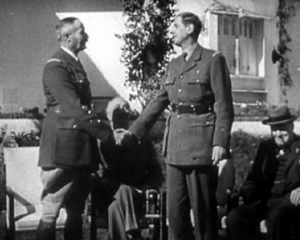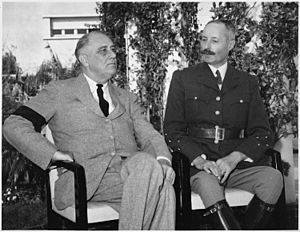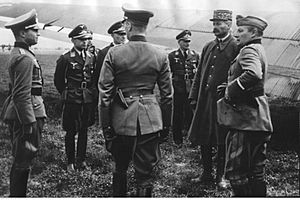Henri Giraud facts for kids
Quick facts for kids
Henri Giraud
|
|
|---|---|

Giraud in Casablanca, 19 January 1943
|
|
| Co-chairman of the French Committee of National Liberation (with Charles de Gaulle) |
|
| In office 3 June 1943 – 9 November 1943 |
|
| Preceded by | Position created |
| Succeeded by | Position abolished |
| Civilian and military commander-in-chief for French North Africa and French West Africa | |
| In office 26 December 1942 – 3 June 1943 |
|
| Preceded by | François Darlan (as High-Commissioner) |
| Succeeded by | Position abolished |
| Member of the Constituent Assembly from Moselle |
|
| In office 11 June 1946 – 27 November 1946 |
|
| Personal details | |
| Born |
Henri Honoré Giraud
18 January 1879 Paris, France |
| Died | 11 March 1949 (aged 70) Dijon, France |
| Political party | PRL |
| Awards | Grand Cross of the Legion of Honor |
| Military service | |
| Allegiance | |
| Branch/service | French Army |
| Years of service | 1900–1944 |
| Rank | Général d'Armée |
| Battles/wars |
|
Henri Honoré Giraud (born 18 January 1879, died 11 March 1949) was a French general. He played an important role in World War II, leading some French forces. He was part of the Free French movement until 1944.
Giraud was born in Paris to a family from Alsace. He went to the Saint-Cyr military academy. He fought in French North Africa. During World War I, he was hurt and captured by the Germans. But he managed to escape from the prison camp.
Between the two World Wars, Giraud returned to North Africa. He fought in the Rif War and received the Légion d'honneur award. Early in World War II, he fought in the Netherlands. In May 1940, he was captured by the Germans again. He made another amazing escape in April 1942 after two years of planning.
From inside Vichy France, he secretly worked with the Allies. He took command of French troops in North Africa after Operation Torch in November 1942. This happened after François Darlan was killed. In January 1943, Giraud met with Charles de Gaulle, Winston Churchill, and Franklin D. Roosevelt at the Casablanca Conference. Later that year, Giraud and de Gaulle became co-leaders of the French Committee of National Liberation. However, Giraud lost support and retired in April 1944.
After the war, Giraud was chosen to be a member of the Constituent Assembly for the French Fourth Republic. He passed away in Dijon in 1949.
Contents
Henri Giraud's Early Life
Henri Giraud was born in Paris, France. His family came from Alsace, a region in eastern France. His father was a coal merchant.
Giraud's Military Career
Giraud finished his studies at the Saint-Cyr Military Academy in 1900. He then joined the French Army. He served in North Africa with the Zouave troops. In 1914, when World War I began, he was sent back to France.
World War I Experience
Giraud was badly wounded during the Battle of St. Quentin (1914) in August 1914. He was captured by the Germans and sent to a prison camp in Belgium. Two months later, he escaped! He pretended to be a worker with a traveling circus. With help from Edith Cavell and her team, he returned to France through the Netherlands. This brave act earned him the Legion of Honour award. After this, Giraud served with French troops in Istanbul.
Between the World Wars
In 1920, Giraud went to Morocco to fight against rebels in the Rif War. He received the Légion d'Honneur after the capture of Abd-el-Krim in 1926. Later, he became a professor of infantry tactics at the École de Guerre. One of his students there was Captain Charles de Gaulle. Giraud was promoted to brigadier-general in 1930. In 1936, he became the military governor of Metz.
World War II: Capture and Escape
When World War II started, Giraud was a high-ranking officer. He became the commander of the 7th Army. In May 1940, his army was sent to the Netherlands. He managed to slow down German troops at Breda. However, he was captured by German troops on 19 May while on patrol. He was taken to Königstein Castle near Dresden, a high-security prison.
Giraud spent two years carefully planning his escape. He learned German and memorized a map of the area. He made a 150-foot (46 m) rope from twine, bedsheets, and copper wire. Friends helped him by secretly sending these items. On 17 April 1942, he used the rope to climb down the fortress cliff. He had shaved his moustache and wore a Tyrolean hat as a disguise. He then traveled by train to the Swiss border. He walked through the mountains to avoid border guards. Finally, he reached Basel, Switzerland, and then slipped into Vichy France.
Once in Vichy France, Giraud revealed his identity. He tried to convince Marshal Pétain that Germany would lose the war. He believed France should fight against the German occupation. His ideas were not accepted, but the Vichy government refused to send him back to the Germans.
Working with the Allies
Giraud's escape quickly became famous across France. The Vichy government's Prime Minister, Pierre Laval, tried to make him return to Germany. But Giraud refused to work with the Germans. In response, Heinrich Himmler ordered the Gestapo to arrest Giraud's family members. Seventeen of his family members were taken hostage.
The Allies secretly contacted Giraud. They gave him the code name Kingpin. Giraud was already thinking about the day American troops would land in France. He agreed to help an Allied landing in French North Africa. He wanted only American troops to be used. He also wanted a French officer, ideally himself, to be the commander of the operation. He felt this was important to keep French control over North Africa.
Giraud met with U.S. General Mark W. Clark and American diplomat Robert Daniel Murphy. They agreed on the invasion plan. Giraud was picked up near Toulon by a British submarine. He was taken to meet General Dwight Eisenhower in Gibraltar on 7 November, just hours before the landings.
Eisenhower asked Giraud to lead French troops in North Africa during Operation Torch. He wanted Giraud to order them to join the Allies. But Giraud had expected to lead the entire operation. He strongly refused to take part in any other way. He said his "honor would be tarnished" if he was just a spectator.
However, the next morning, Giraud changed his mind. He flew to Algiers on 9 November. But his attempt to take command of French forces was not successful. His message telling French troops to stop fighting and join the Allies was ignored. Instead, Admiral François Darlan, who was in Algiers, seemed to have the real power. The Allies recognized Darlan as the head of French forces in Africa. On 10 November, Darlan ordered the French forces to stop fighting and work with the Allies.
On 11 November, German forces occupied southern France. Negotiations continued in Algiers. By 13 November, the Allies recognized Darlan as the High Commissioner of French North Africa. Giraud was appointed commander of all French forces under Darlan. This happened without involving De Gaulle's Free French Forces, who claimed to be the true government of France.
Then, on 24 December 1942, Darlan was killed in Algiers. A young man named Fernand Bonnier de La Chapelle shot him. The young man was quickly tried and executed under Giraud's orders. With strong support from the Allies, Giraud was chosen to take Darlan's place.
Leader of the Army of Africa

After Admiral Darlan's death, Giraud became his successor with Allied support. This involved discussions between Giraud and Charles de Gaulle. De Gaulle wanted to focus on political leadership in France. He agreed to have Giraud as commander-in-chief because Giraud was more experienced militarily.
Giraud took part in the Casablanca Conference (1943) in January 1943. He met with Roosevelt, Churchill, and de Gaulle. After difficult talks, Giraud agreed to remove certain laws. He also agreed to free prisoners from concentration camps in South Algeria. Henri Giraud and Charles de Gaulle then became co-presidents of the French Committee of National Liberation and Free French Forces.

De Gaulle became more powerful politically than Giraud. Giraud traveled to the U.S. in July, which was not very helpful for his position. Meanwhile, de Gaulle gained more strength.
After a resistance uprising in Corsica on 11 September 1943, Giraud sent help. He sent an expedition, including two French destroyers, to support the resistance. He did this without telling the committee. This led to more criticism from de Gaulle. Giraud lost his co-presidency in November 1943.
When the Allies found out that Giraud had his own secret intelligence network, the French committee removed him from his role as commander-in-chief. He refused another military position and chose to retire after 44 years of service. On 10 March 1944, he received a message from Winston Churchill. Churchill expressed sympathy for the death of Giraud's daughter. She had been captured in Tunisia and taken to Germany with her four children.
Life After the War
On 2 June 1946, Henri Giraud was elected to the French Constituent Assembly. He represented the Republican Party of Liberty. He helped create the constitution for the French Fourth Republic. He remained a member of the War Council. He also received an award for his famous escape.
Giraud wrote two books about his experiences: Mes Evasions (My Escapes, 1946) and Un seul but, la victoire: Alger 1942–1944 (A Single Goal, Victory: Algiers 1942–1944, 1949).
Henri Giraud passed away in Dijon, France, on 11 March 1949.
Military Ranks
Legion d'Honneur 1926
Decorations
 Academic Officer (Silver Palms) (July 1929)
Academic Officer (Silver Palms) (July 1929) War Cross 1914–1918
War Cross 1914–1918 War Cross 1939–1945
War Cross 1939–1945 War Cross for Foreign Theatres of Operations
War Cross for Foreign Theatres of Operations Escapees' Medal (12 October 1927)
Escapees' Medal (12 October 1927) 1914–1918 Inter-Allied Victory medal (France)
1914–1918 Inter-Allied Victory medal (France) 1914–1918 Commemorative war medal (France)
1914–1918 Commemorative war medal (France)
See also
 In Spanish: Henri Giraud para niños
In Spanish: Henri Giraud para niños
- Liberation of France
- Operation Kingpin (World War II)




